These 7 inverter circuits might look simple with their designs, but are able to produce a reasonably high power output and an efficiency of around 75%. Learn how to build this cheap mini inverter and power small 220V or 120V appliances such drill machines, LED lamps, CFL lamps, hair dryer, mobile chargers, etc through a 12V 7 Ah battery.
What is a Simple Inverter
An inverter which uses minimum number of components for converting a 12 V DC to 230 V AC is called a simple inverter. A 12 V lead acid battery is the most standard form of battery which is used for operating such inverters.
Let's begin with the most simplest in the list which utilizes a couple of 2N3055 transistors and some resistors.
1) Simple Inverter Circuit using Cross Coupled Transistors
The article deals with the construction details of a mini inverter. Read to know regrading the construction procedure of a basic inverter which can provide reasonably good power output and yet is very affordable and sleek.
There may be a huge number of inverter circuits available over the internet and electronic magazines. But these circuits are often very complicated and hi-end type of inverters.
Thus we are left with no choice but just to wonder how to build power inverters that can be not only easy to build but also low cost and highly efficient in its working.
12v to 230v inverter circuit diagram
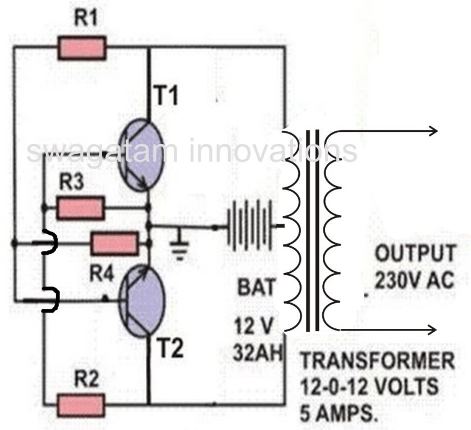
Well your search for such a circuit ends here. The circuit of an inverter described here is perhaps the smallest as far its component count goes yet is powerful enough to fulfill most of your requirements.
Construction Procedure
To begin with, first make sure to have proper heatsinks for the two 2N3055 transistors. It can be fabricated in the following manner:
- Cut two sheets of aluminum of 6/4 inches each.

- Bend one end of the sheet as shown in the diagram. Drill appropriate sized holes on to the bends so that it can be clamped firmly to the metal cabinet.
- If you find it difficult to make this heatsink you can simply purchase from your local electronic shop shown below:
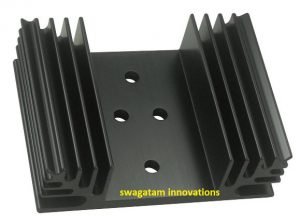
- Also drill holes for fitting of the power transistors. The holes are 3mm in diameter, TO-3 type of package size.
- Fix the transistors tightly on to the heatsinks with the help of nuts and bolts.
- Connect the resistors in a cross-coupled manner directly to the leads of the transistors as per the circuit diagram.
- Now join the heatsink, transistor, resistor assembly to the secondary winding of the transformer.
- Fix the whole circuit assembly along with the transformer inside a sturdy, well ventilated metal enclosure.
- Fit the output and input sockets, fuse holder etc. externally to the cabinet and connect them appropriately to the circuit assembly.
Once the above heatsink installation is over, you simply need to interconnect a few high watt resistors and the 2N3055 (on heatsink) with the selected transformer as given in the following diagram.
Complete Wiring Layout
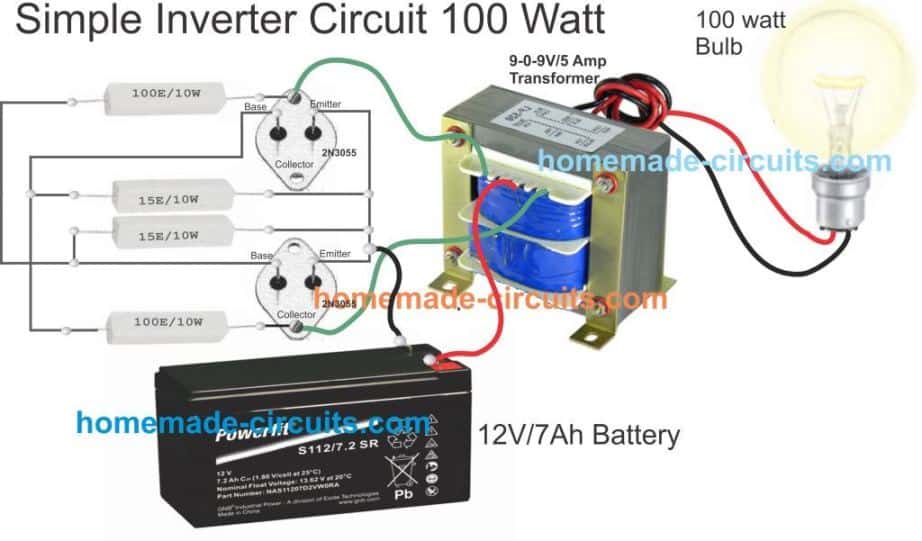
After the above wiring is completed, it's time to hook it up with a 12V 7Ah battery, with a 60 watt lamp attached at the transformer secondary. When switched ON the result would be an instant illumination of the load with an astonishing brightness.
Here the key element is the transformer, make sure the transformer is genuinely rated at 5 amp, otherwise you may find the output power a lot lesser than the expectation.
I can tell this from my experience, I built this unit twice, once when I was in college, and the second time recently in the year 2015. Although I was more experienced during the recent venture I could not get the awesome power that I had acquired from my previous unit. The reason was simple, the previous transformer was a robust custom built 9-0-9V 5 amp transformer, compared to the new one in which I had used probably a falsely rated 5 amp, which was actually only 3 amp with its output.
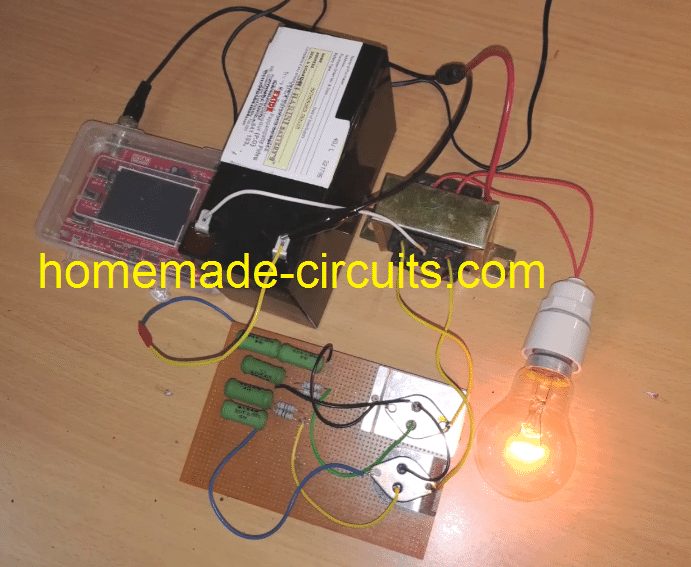
Parts List
You will require just the following few components for the construction:
- R1, R2= 100 OHMS./ 10 WATTS WIRE WOUND
- R3, R4= 15 OHMS/ 10 WATTS WIRE WOUND
- T1, T2 = 2N3055 POWER TRANSISTORS (MOTOROLA).
- TRANSFORMER= 9- 0- 9 VOLTS / 8 AMPS or 5 amps.
- AUTOMOBILE BATTERY= 12 VOLTS/ 10Ah
- ALUMINUM HEATSINK= CUT AS PER THE REQUIRED SIZE.
- VENTILATED METAL CABINET= AS PER THE SIZE OF THE WHOLE ASSEMBLY
Video Test Proof
How to Test it?
- The testing of this mini inverter is done in the following method:
- For testing purpose connect a 60 watt incandescent bulb to the output socket of the inverter.
- Next, connect a fully charged 12 V automobile battery to its supply terminals.
- The 60 watt bulb should immediately light up brightly, indicating that the inverter is functioning properly.
- This concludes the construction and the testing of the inverter circuit.
- I hope from the above discussions you must have clearly understood how to build an inverter which is not only simple to construct but also very affordable to each of you.
- It can be used to power small electrical appliances like soldering iron, CFL lights, small portable fans etc. The output power will lie in the vicinity of 70 watts and is load dependent.
- The efficiency of this inverter is around 75%. The unit may be connected to your vehicles battery itself when outdoors so that the trouble of carrying an extra battery is eliminated.
Circuit Operation
The functioning of this mini inverter circuit is rather unique and different from the normal inverters which involve discrete oscillator stage for powering the transistors.
However here the two sections or the two arms of the circuit operate in a regenerative manner. Its very simple and may be understood through the following points:
The two halves of the circuit no matter how much they are matched will always consist a slight imbalance in the parameters surrounding them, like the resistors, Hfe, transformer winding turns etc.
Due to this, both the halves are not able to conduct together at one instant.
Assume that the upper half transistors conduct first, obviously they will be getting their biasing voltage through the lower half winding of the transformer via R2.
However the moment they saturate and conduct fully, the entire battery voltage is pulled through their collectors to the ground.
This sucks-out dry any voltage through R2 to their base and they immediately stop conducting.
This gives an opportunity for the lower transistors to conduct and the cycle repeats.
The whole circuit thus starts to oscillate.
The base Emitter resistors are used to fix a particular threshold for their conduction to break, they help to fix a base biasing reference level.
The above circuit was inspired from the following design by Motorola:
UPDATE: You may also want to try this: 50 watt Mini Inverter Circuit
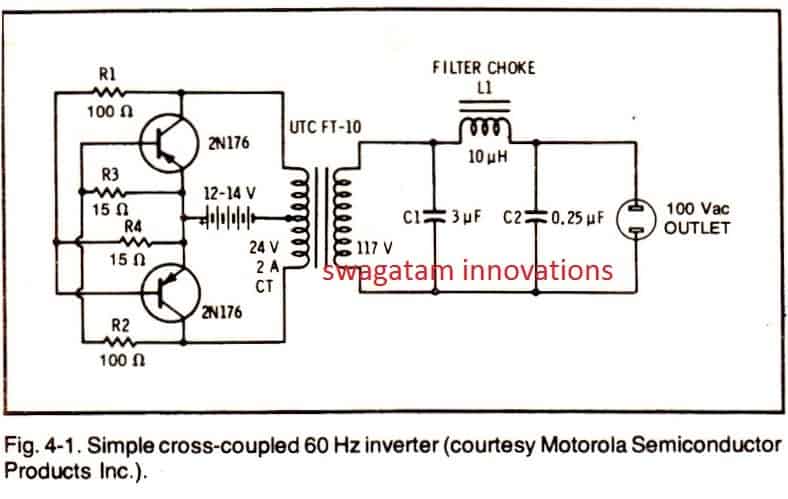
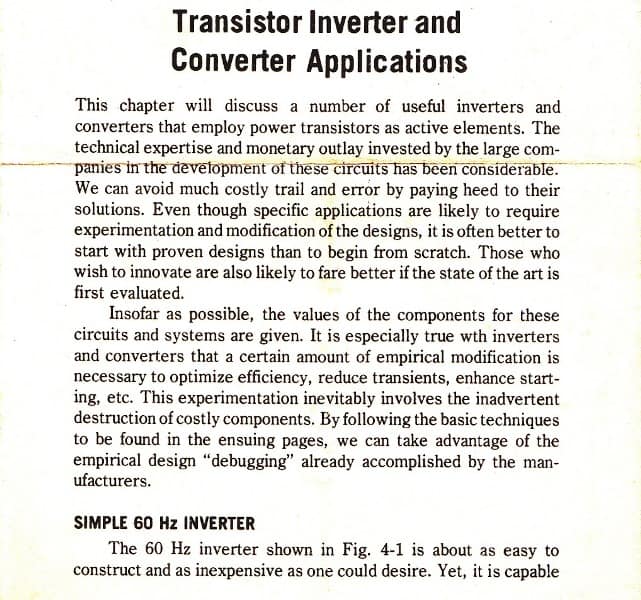
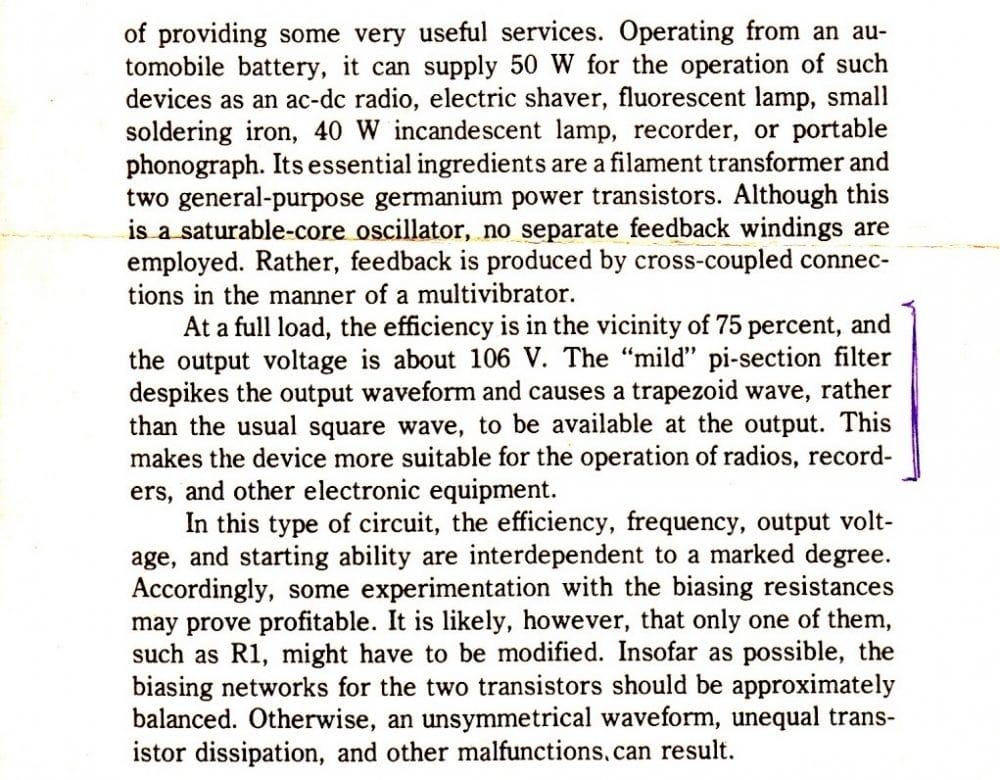
Output Waveform better than square wave (Reasonably suitable for all electronic appliances))
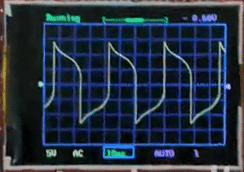
PCB Design for the above explained simple 2N3055 Inverter Circuit (Track Side Layout)
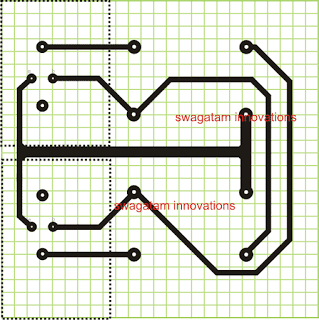
Cross Coupled MOSFET Inverter
The next design is a cross coupled simple MOSFET inverter circuit will be able to supply 220V/120V AC mains voltage or DC volts (with a rectifier and filter). The circuit is an easy to build inverter that will boost 12 or 14 volts to any level depending on the transformer secondary rating.
In this circuit, the primary and secondary of transformer T1 is a 12.6 V to 220 V step down transformer, connected in the reverse format.
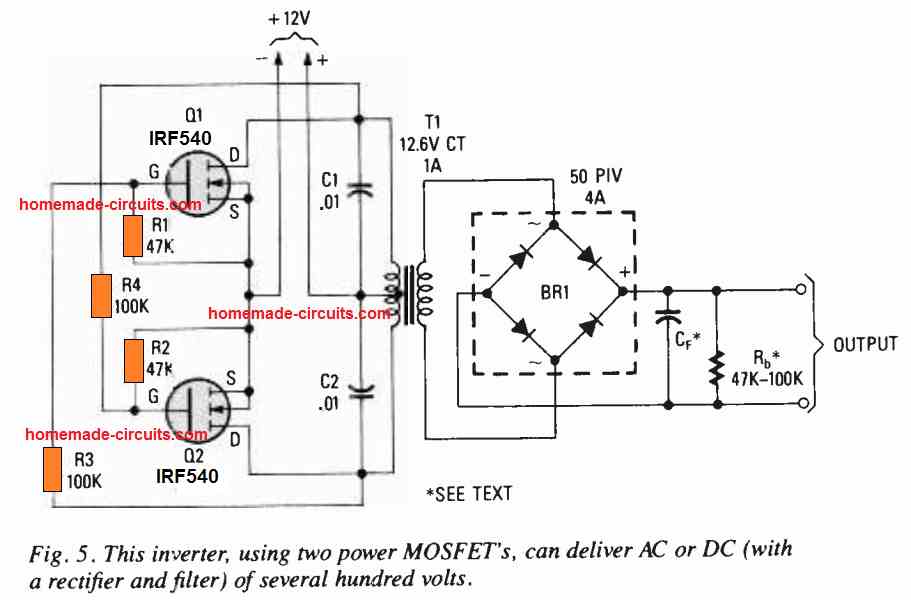
MOSFETs Q1 and Q2 can be any high power Nchannel FETs. Do not forget to apply heat sink to the MOSFETs Q1 and Q2. Capacitors C1 and C2 are positioned in order to suppress high voltage reverse spikes from the transformer. You can use any nearby value for the resistors R1-R4 having a tolerance of ± 20% to the shown values in the diagram.
The circuit is perfect to power a tube circuit, or it could be coupled with a step-up transformer to generate a spark gap, a Jacob's Ladder, or, by adjusting the frequency, it could be accustomed to energize a Tesla coil.
2) Using IC 4047
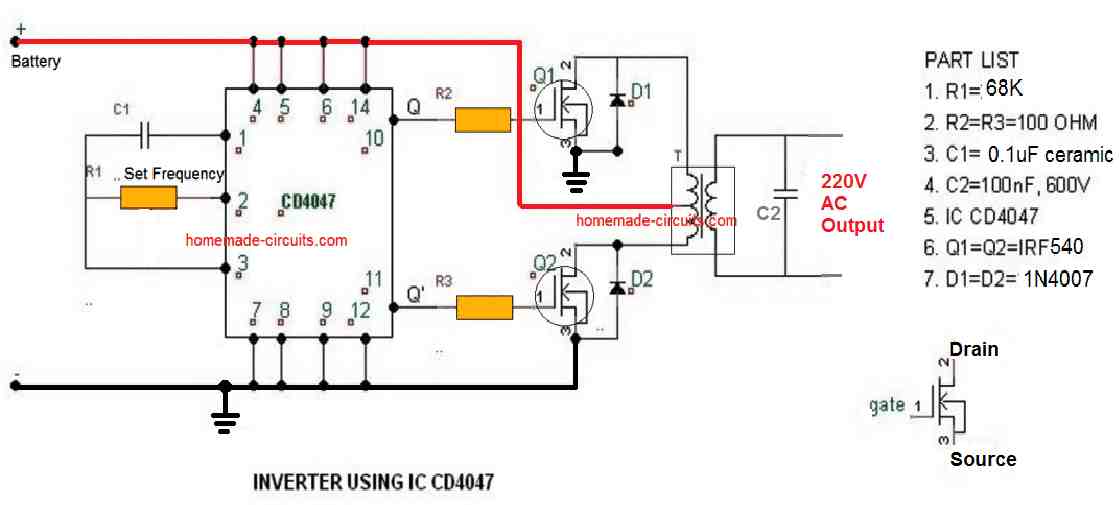
As shown above a simple yet useful little inverter can be built using just a single IC 4047. The IC 4047 is a versatile single IC oscillator, which will produce precise ON/OFF periods across its output pin#10 and pin#11. The frequency here could be determined by accurately calculating the resistor R1 and capacitor C1. These components determine the oscillation frequency at the output of the IC which in turn sets the output 220V AC frequency of this inverter circuit. It may set at 50Hz or 60Hz as per individual preference.
The battery, mosfet and the transformer can be modified or upgraded as per the required output power specification of the inverter.
For calculating the RC values, and the output frequency please refer to the datasheet of the IC
Video Test Results
3) Using IC 4049
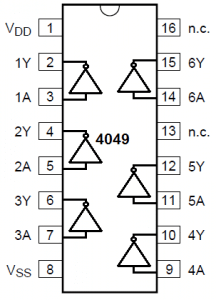
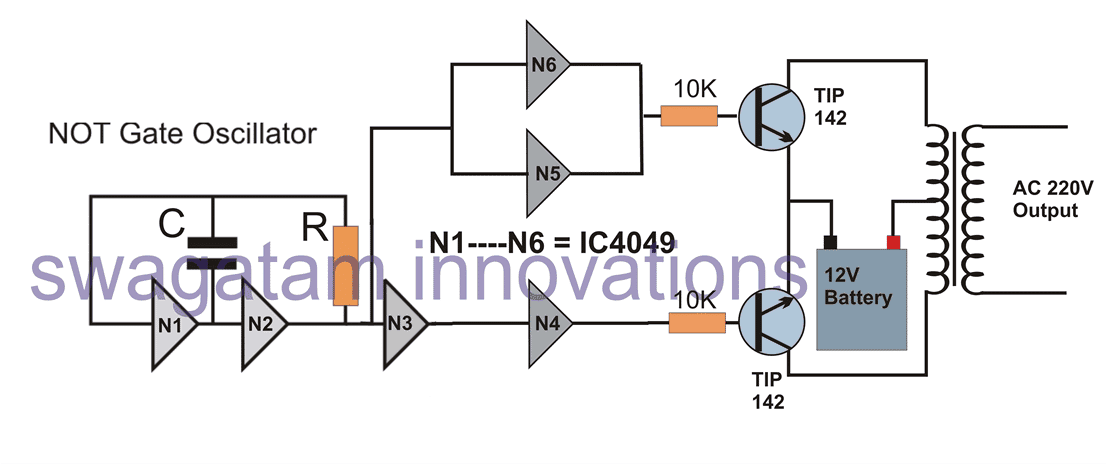
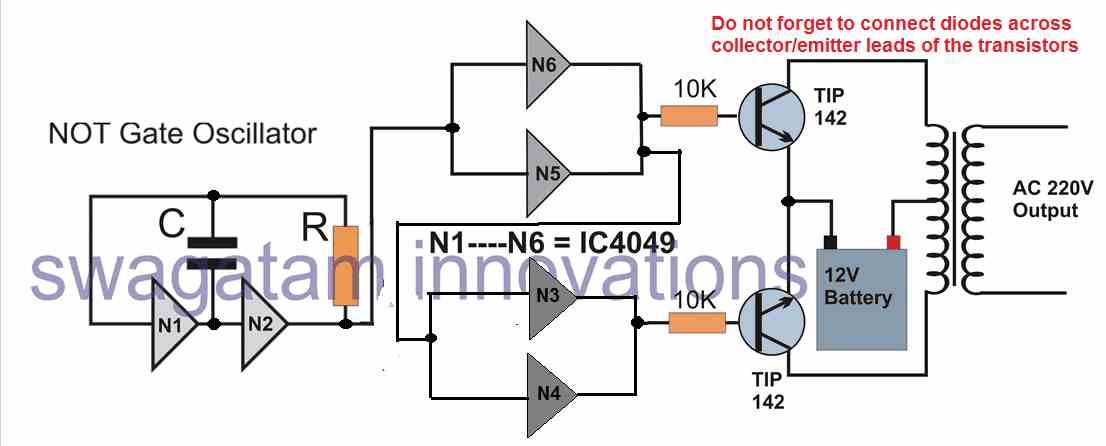
In this simple inverter circuit we use a single IC 4049 which includes 6 NOT gates or 6 inverters inside. In the diagram above N1----N6 signify the 6 gates which are configured as oscillator and buffer stages. The NOT gates N1 and N2 are basically used for the oscillator stage, the C and R can be selected and fixed for determining the 50Hz or 60 Hz frequency as per country specs
The remaining gates N3 to N6 are adjusted and configured as buffers and inverters so that the ultimate output results in producing alternating switching pulses for the power transistors. The configuration also ensures that no gates are left unused and idle, which may otherwise require their inputs to be terminated separately across a supply line.
The transformer and battery may be selected as per the power requirement or the load wattage specifications.
The output will be purely a square wave output.
Formula for calculating frequency is given as:
f = 1 /1.2RC,
where R will be in Ohms and F in Farads
4) Using IC 4093
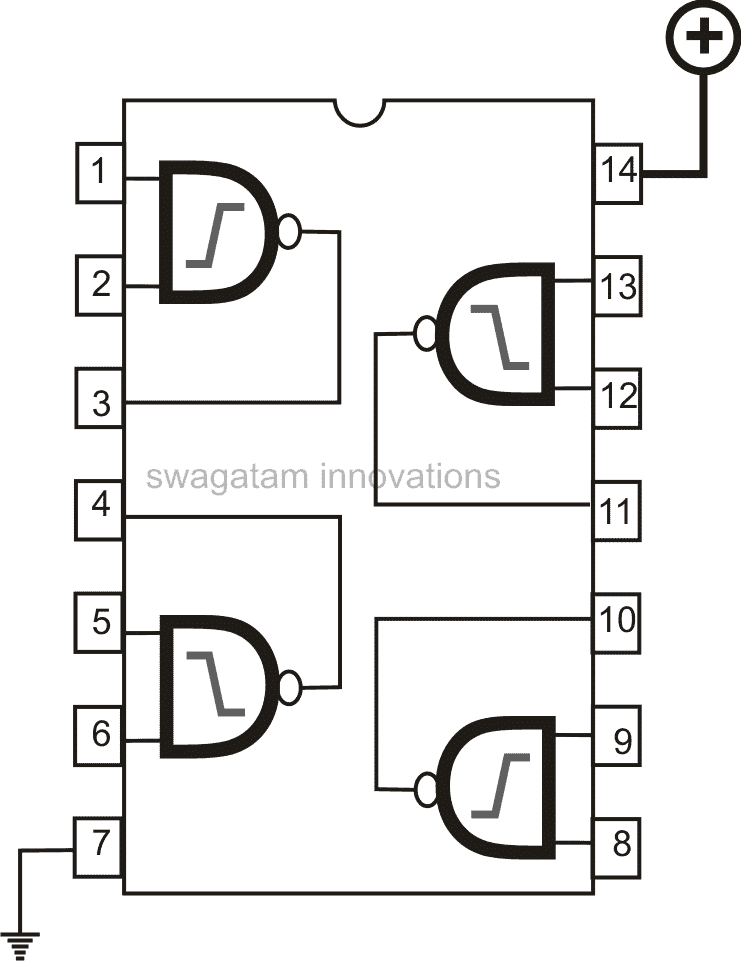
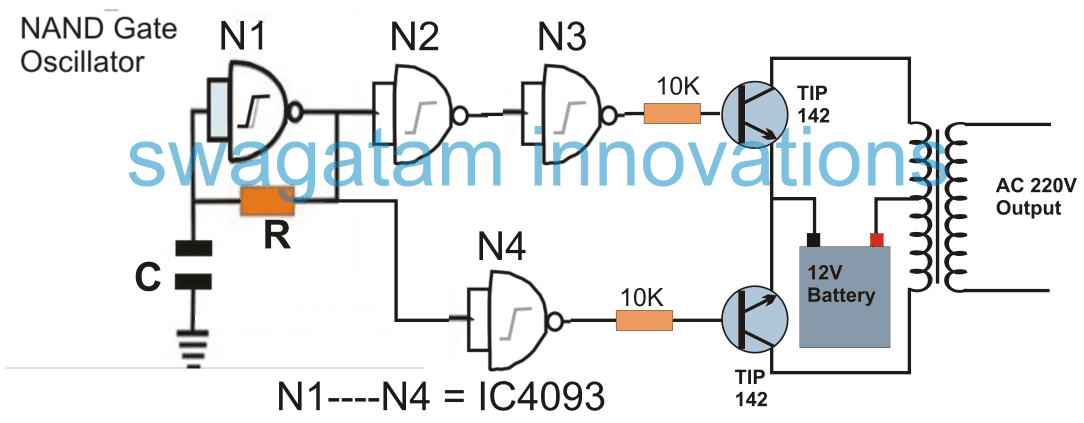
Quite similar to the previous NOT gate inveter, the NAND gate based simple inverter shown above can be built using a single 4093 IC. The gates N1 to N4 signify the 4 gates inside the IC 4093.
N1, is wired as an oscillator circuit, for generating the required 50 or 60Hz pulses. These are appropriately inverted and buffered using the remaining gates N2, N3, N4 in order to finally deliver the alternately switching frequency across the bases of the power BJTs, which in turn switch the power transformer at the supplied rate for generating the required 220V or 120V AC at the output.
Although any NAND gate IC would work here, using the IC 4093 is recommended since it features Schmidt trigger facility, which ensures a slight lag in switching and helps creating a kind of dead-time across the switching outputs, making sure that the power devices are never switched ON together even for a fraction of a second.
5) Another Simple NAND gate Inverter using MOSFETs
Another simple yet powerful inverter circuit design is explained in the following paragraphs which can be built by any electronic enthusiast and used for powering most of the household electrical appliances (resistive and SMPS loads).
The use of a couple of mosfets influences a powerful response from the circuit involving very few components, however the square wave configuration does limit the unit from quite a few useful applications.
Introduction
Calculating MOSFET parameters may seem to involve a few difficult steps, however by following the standard design enforcing these wonderful devices into action is definitely easy.
When we talk about inverter circuits involving power outputs, MOSFETs imperatively become a part of the design and also the main component of the configuration, especially at the driving output ends of the circuit.
Inverter circuits being the favorites with these devices, we would be discussing one such design incorporating MOSFETs for powering the output stage of the circuit.
Referring to the diagram, we see a very basic inverter design involving a square wave oscillator stage, a buffer stage and the power output stage.
The use of a single IC for generating the required square waves and for buffering the pulses particularly makes the design easy to make, especially for the new electronic enthusiast.
Using IC 4093 NAND Gates for the Oscillator Circuit
The IC 4093 is a quad NAND gate Schmidt Trigger IC, a single NAND is wired up as an astable multivibrator for generating the base square pulses. The value of the resistor or the capacitor may be adjusted for acquiring either a 50 Hz or 60 Hz pulses. For 220 V applications 50 Hz option needs to be selected and a 60 Hz for the 120 V versions.
The output from the above oscillator stage is tied with a couple of more NAND gates used as buffers, whose outputs are ultimately terminated with the gate of the respective MOSFETs.
The two NAND gates are connected in series such that the two mosfets receive opposite logic levels alternately from the oscillator stage and switch the MOSFETs alternately for making the desired inductions in the input winding of the transformer.
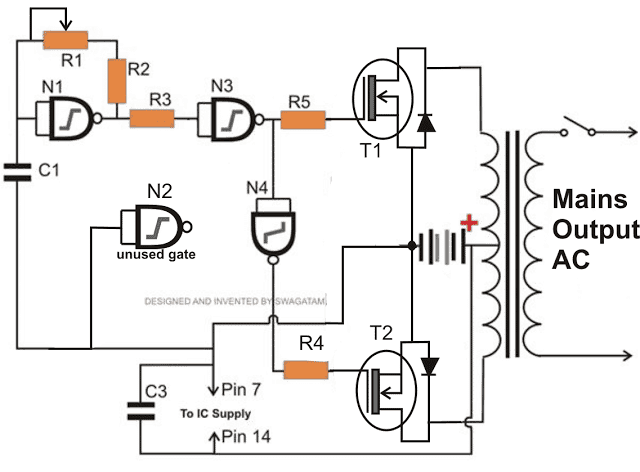
Mosfet Switching
The above switching of the MOSFETs stuffs the entire battery current inside the relevant windings of the transformer, inducing an instant stepping up of the power at the opposite winding of the transformer where the output to the load is ultimately derived.
The MOSFETs are capable of handling more than 25 Amps of current and the range is pretty huge and therefore becomes suitable driving transformers of different power specs.
It’s just a matter of modifying the transformer and the battery for making inverters of different ranges with different power outputs.
Parts List for the above explained 150 watt inverter circuit diagram:
- R1 = 220K pot, needs to be set for acquiring the desired frequency output.
- R2, R3, R4, R5 = 1K,
- T1, T2 = IRF540
- N1—N4 = IC 4093
- C1 = 0.01uF,
- C3 = 0.1uF
TR1 = 0-12V input winding, current = 15 Amp, output voltage as per the required specs
Formula for calculating frequency will be identical to the one described above for IC 4049.
f = 1 /1.2RC. where R = R1 set value, and C = C1
6) Using IC 4060
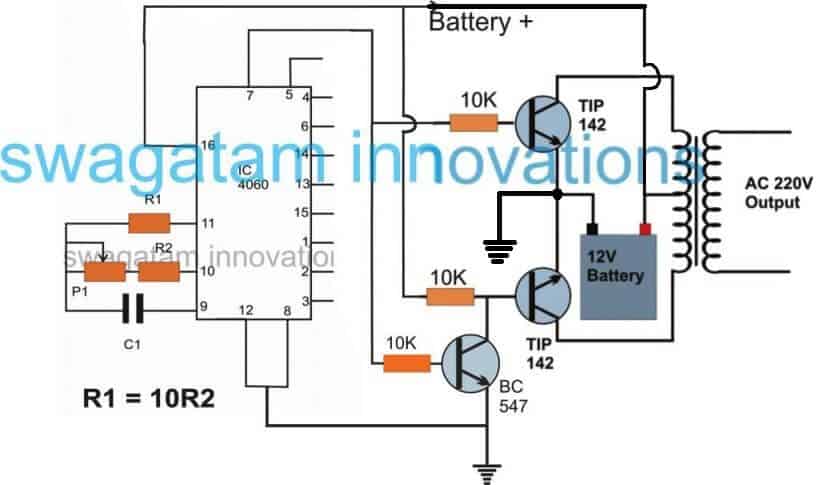
If you have a single 4060 IC in your electronic junk box, along with a transformer and a few power transistors, you are probably all set to create your simple power inverter circuit using these components. The basic design of the proposed IC 4060 based inverter circuit can be visualized in the above diagram. The concept is basically the same, we use the IC 4060 as an oscillator, and set its output to create alternately switching ON OFF pulses through an inverter BC547 transistors stage.
Just like IC 4047, the IC 4060 requires an external RC components for setting up its output frequency, however, the output from the IC 4060 are terminated into 10 individual pinouts in a specific order wherein the output generate frequency at a rate twice that of its preceding pinout.
Although you may find 10 separate outputs with a rate of 2X frequency rate across the IC output pinouts, we have selected the pin#7 since it delivers the fastest frequency rate among the rest and therefore may fulfil this using standard components for the RC network, which may be easily available to you no matter in which part of the globe you are situated in.
For calculating the RC values for R2 +P1 and C1 and the frequency you can use the formula as described below:
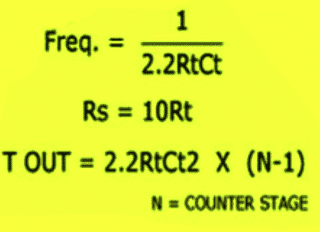
Or another way is through the following formula:
f(osc) = 1 / 2.3 x Rt x Ct
Rt is in Ohms, Ct in Farads
More info can be obtained from this article
Here's yet another cool DIY inverter idea which is extremely reliable and uses ordinary parts for accomplishing a high power inverter design, and can be upgraded to any desired power level.
I have explained more about this simple design
7) Simplest 100 Watt Inverter for the Newcomers
The circuit of a simple 100 watt inverter discussed in this article can be considered as the most efficient, reliable, easy to build and powerful inverter design. It will convert any 12V to 220V effectively using minimum components
Introduction
The idea was published many years back in one of the elecktor electronics magazines, I present it here so that you all can make and use this circuit for your personal applications. I have explained more.
The proposed simple 100 watt inverter circuit disign was published quite a long time ago in one of the elektor electronics magazines and according to me this circuit is one of the best inverter designs you can get.
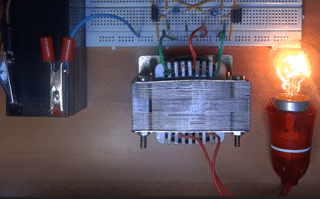
I consider it to be the best because the design is well balanced, well calculated, utilizes ordinary parts and if done everything correctly would start working instantly.
The efficiency of this design is in the vicinity of 85% that's good considering the simple format and low costs involved.
Using an Transistor Astable as the 50Hz Oscillator
Basically the whole design is built around an astable multivibrator stage, consisting of two low power general purpose transistors BC547 along with the associated parts consisting of two electrolytic capacitors and some resistors.
This stage is responsible for generating the basic 50 Hz pulses required for initiating the inverter operations.
The above signals are at low current levels and therefore requires to be lifted to some higher orders. This is done by the driver transistors BD680, which are Darlington by nature.
These transistors receive the low power 50 Hz signals from the BC547 transistor stages and lift them at higher current levels so that it can be fed to the output transistors.
The output transistors are a pair of 2N3055 which receive an amplified current drive at their bases from the above driver stage.
2N3055 Transistors as the Power Stage
The 2N3055 transistors thus are also driven at high saturation and high current levels which gets pumped into the relevant transformer windings alternately, and converted into the required 220V AC volts at the secondary of the transformer.
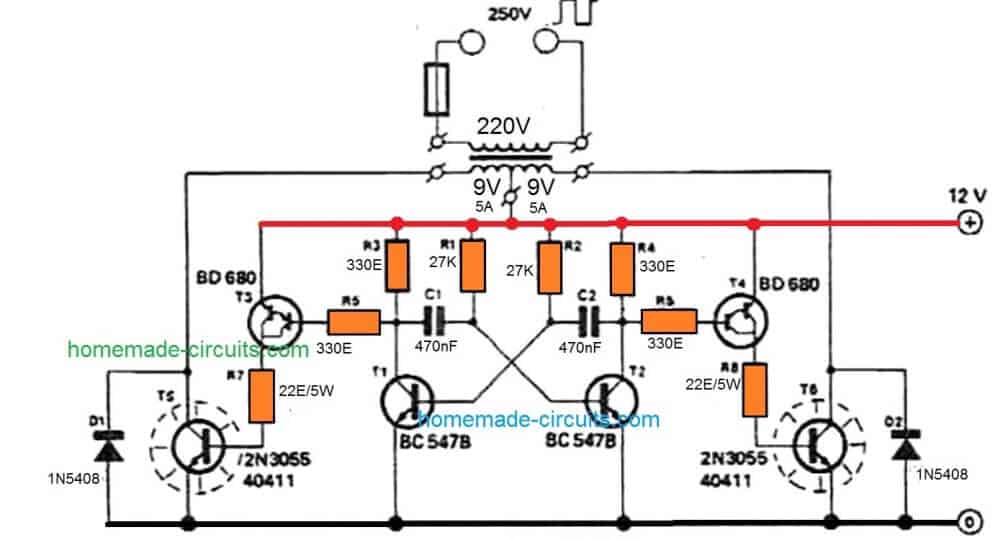
Parts List for the above explained simple 100 watt inverter circuit
- R1,R2 = 27K, 1/4 watt 5%
- R3,R4,R5,R6 = 330 OHMS, 1/4 watt 5%
- R7,R8 = 22 OHMS, 5 WATT WIRE WOUND TYPE
- C1,C2 = 470nF
- T1,T2 = BC547,
- T3,T4 = BD680, OR TIP127
- T5,T6 = 2N3055,
- D1,D2 = 1N5402
- TRANSFORMER = 9-0-9V, 5 AMP
- BATTERY = 12V,26AH,
Heatsink for the T3/T4, and T5/T6
Specifications:
- Power Output: 100 watts if single 2n3055 transistors are used on each channels.
- Frequency: 50 Hz, Square Wave,
- Input Voltage: 12V @ 5 Amps for 100 Watts,
- Output Volts: 220V or 120V(with some adjustments)
From the above discussion you might be feeling thoroughly enlightened regarding how to build these 7 simple inverter circuits, by configuring a given basic oscillator circuit with a BJT stage and a transformer, and by incorporating very ordinary parts which may be already existing with you or accessible by salvaging an old assembled PC board.
How to Calculate the Resistors and Capacitors for 50 Hz or 60 Hz Frequencies
In this transistor based inverter circuit, the oscillator design is built using a transistorized astable circuit.
Basically the resistors and capacitors associated with the bases of the transistors determine the frequency of the output. Although these are correctly calculated to produce approximately 50 Hz frequency, if you are further interested to tweak the output frequency as per own preference you can easily do so by calculating them through this Transistor Astable Multivibrator Calculator.
Another Simple Transistorized DC to AC Inverter Circuit
Q1 and Q2 can be any small signal PNP transistor such as BC557.
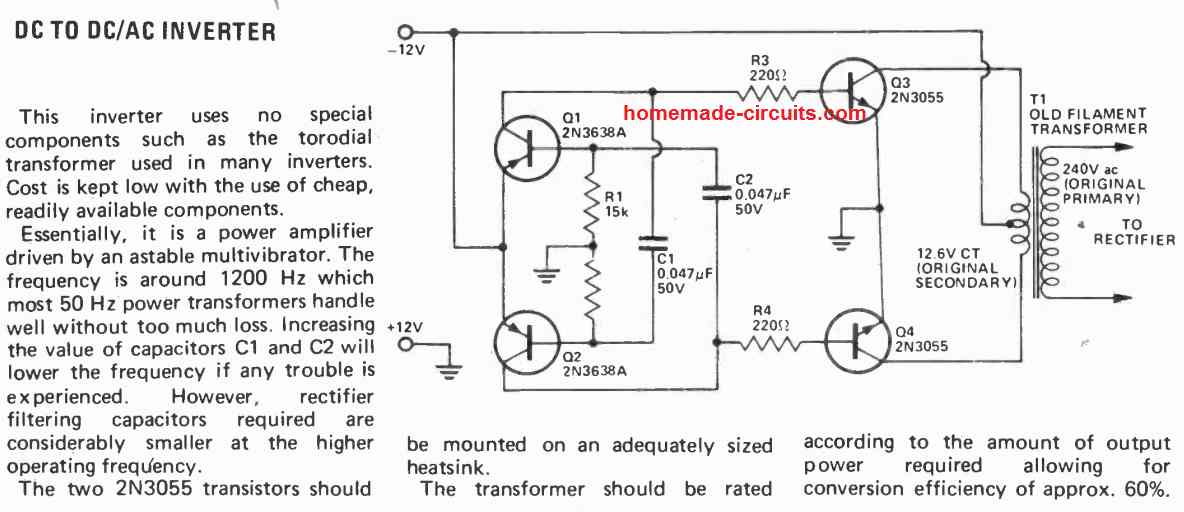
Universal Push-Pull Module
If you are interested to achieve a more compact an efficient design using a simple a 2 wire transformer push pull configuration, then you can try the following couple of concepts
The first one below uses the IC 4047, along with a couple of p channel and n channel MOSFETs:
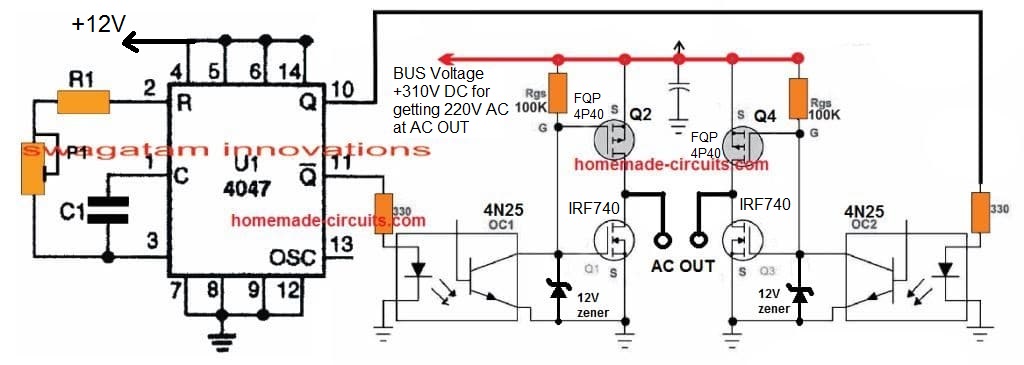
If you wish to employ some other oscillator stage as per your preference, in that case you can apply the following universal design.
This will allow you to integrate any desired oscillator stage and get the required 220 V push pull output.
Moreover it also has an integrated auto-changeover battery charger stage.
Advantages of Simple Push-Pull Inverter
The main advantages of this universal push-pull inverter design are:
- It uses a 2 wire transformer, which makes the design highly efficient, in terms of size and power output.
- It incorporates a changeover with battery charger, which charges the battery when the mains is present, and during a mains failure changes over to inverter mode using the same battery to produce the intended 220 V from the battery.
- It uses ordinary p-channel and N-channel MOSFETs without any complex circuitry.
- It is cheaper to build and more efficient than the center tap counterpart.
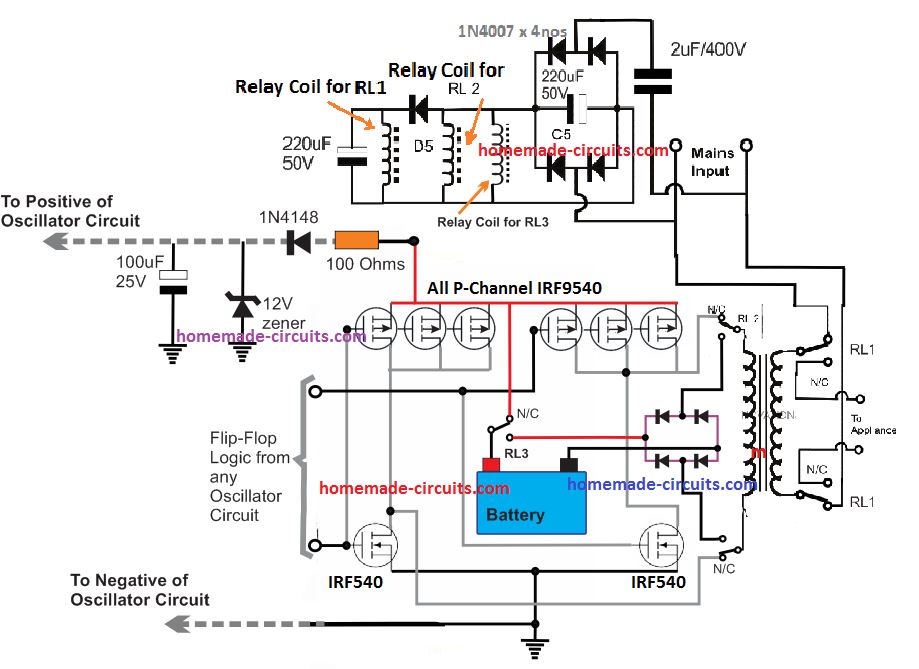
SCR Inverter
The following inverter circuit uses SCRs instead of transistors and thus allows even higher power output with a simple configuration.
The oscillation is triggered by a pair of UJTs, which ensure accurate frequency control , and also facilitates the adjustment of the frequency across the two SCRs
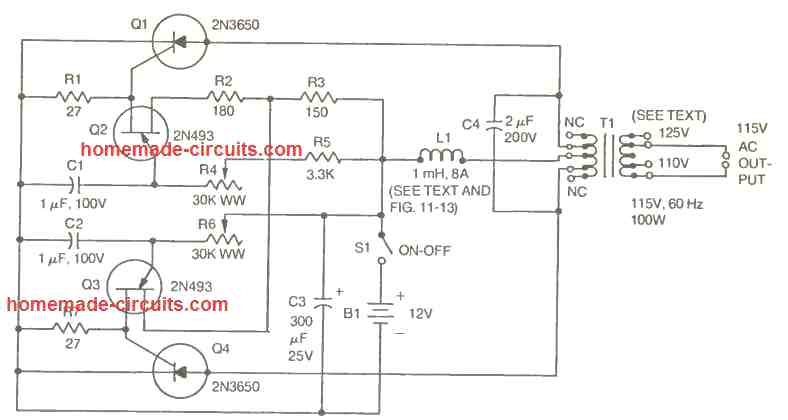
The transformer can be be any ordinary iron core 9-0-9 V to 220 V or 120 V step down transformer, connected in the reverse order.
For the Advanced Users
The above explained were a few straightforward inverter circuit designs, however if you think these are pretty ordinary for you, you can always explore more advanced designs which are included in this website. Here are a few more links for your reference:
More Inverter Projects for You with Full online Help!




pls sir I just the one of the diagram specifically fig 2 using cd4047 one of the transistor is very hot and one is not working although no output
what you is wrong because I use my meter and check there’s voltage flowing through the gate
Okon, I think your MOSFETTs are blown, or maybe not good.
Please remove the MOSFETs and initially try with BJTs, such as TIP122 and check the response…
With BJTs make sure the base resistor is above 1k….
Hi Swagatam
Im looking at building a 200W inverter (12V -> 240VAC).
However, 9-0-9 10A transformers are difficult to get in UK.
I can however get 12-0-12
https://uk.farnell.com/multicomp-pro/mcta250-12/transformer-toroidal-2-x-12v-250va/dp/9530720
Ideally I’d like to include over temperature as well as low battery.
Would it also be possible to arrange a circuit that would allow charging of a 12V 80Ah battery using the same transformer ?
I have emailed you
Hi Paul,
With a 12V transformer, when your battery voltage drops to 11V, the AC output from the transformer could drop to 200V or lower, that is why a 9V transformer is recommended.
Yes, an automatic charger can be included using the same transformer through relays, as discussed in the following article:
https://www.homemade-circuits.com/single-transformer-inverterchargerchang/
Respected Sir
I am refering to the inverter circuit (Using IC 4060). This circuit is decently made using only one output but the query is that can we use all the outputs or maximum outputs using 1 or 2.2 or 10 meg resistance??? Obviously not disturbing it’s oscillation.
Please help.
Dhananjay, All the outputs of the 4060 IC generate different frequencies, so you can select any one of them which matches the frequency of your inverter.
l designed a simple power supply using rectifier diodes 1 n4001, 25v 470 uF Cin,7815 voltage regulator,470 uF 16 v Cout, and 220/24 vac transformer to power your simple ups battery charging circuit.
But it failed to power an already made 12 vdc/220 vac 300w ECCO inverter.
the input capacitor burned.
so what can be the problem and solution.
Please comment under the same article which you are referring to and please specify the circuit diagram also, I will try to help!
you’re doing great! Could you please help me with the circuit of 4KVA inverter
Please provide the detailed specifications of the inverter, i will try to figure out…
I tried the one with ic 4047 using irfz3205 but after I while one stopped working and the gate resistor started heating up before this the mosfet what making noise not really audible but when I get close I could hear it and also when only one side was working I only loaded the CRT with 15watt bulb and the second mosfet went of Total what can be the cause??
although I used a 1.2amp 12.0 12 transformer
It seems like the MOSFETs are not good and have some internal defect, or maybe they are not original devices.
You can try using BJTs instead and check the response. Any power BJT such as TIP122 should work.
If BJTs work normally, then the problem is certainly with your MOSFETs.
Hello sir I wish to know you better. You’re a great inspiration to me .
In the inverter made by using cross-coupled transistors, why the two 2N3055 transistors don’t conduct together? Can you please give a more in-depth and technical explanation?
the two 2N3055 transistors don’t conduct together because the characteristics of no two transistor or inductance of the winding can be 100% identical, therefore one of the stages will start before the other, triggering the oscillating action.
Thanks for answering, I’ve one more question will it still oscillate and produce ac signal without the base emitter resistors?
It will oscillate even without the base emitter resistors.
hello buddy, how are you doing today,am asking whether I can use an audio transistor in an inverter?
You can use any type of transistor in an inverter circuit, just make sure the current and voltage ratings match the inverter battery/transformer specifications.
Hello Swagatam, if I use any of your inverter circuits here with a 500watts round transformer. Then use 14pcs of mosfets that is 7pcs each on both sides. Then use it on a 200ah 12v battery. Can it work sufficiently or I reduce the number of mosfet?
Thanks.
Hello Morris,
Yes, it will efficiently without any issues. You can use IRF3205 MOSFETs
good day boss.
can this project power tv and fan
Yes, the inverter designs can be used to power TVs and fans
thank you sir
Hello Swagatam. For the Cross Coupled MOSFET Inverter, I could not find a value for the capacitor designated as Cf at the output.
Hello Simon, the Cf can be a 100 uF / 400V filter capacitor.
Thank you
Hello, can I change the 2N3055 transistor to any other transistor like 2sc5200.
Thanks.
You can try 2SC5200, but it won’t be as efficient as 2N3055, because it has a high VCEO of 230V…this should be below 100 V.
Thanks
In number 3) circuit diagram below
Which number of resistor and capacitor can I use to generate clean 60hz
I think roughly it is 0.01uF and 100K, but you will have to use a frequency meter to adjust it accurately.
On the push pull inverter circuit are the gates on each set of mosfets joined together, the lines appear to be missing on the circuit. Thank you,
Yes all the gates of the mosfets on each group are joined together.
Am from Nigeria I made the astable multivibrator circuit using transistor, resistor, capacitor and mosfet but the problem is that one mosfet burn and the other mosfet just continue working but what surprised me is the despite one mosfet working and the other burnt the circuit still workes but I don’t know why
Can you please provide the link of the circuit diagram?
I built the cross coupled using 2n3055 power transistors. Working perfectly…handy and reliable it is.
Thank you for trying this circuit, glad it is working!
Hello I built the Cross Coupled 2n3055 inverter with a good result. I am now interested in the Cross Coupled MOSFET Inverter. Do the mosfets inherently run cooler than the BJT’s? Could I also use zeners instead of the mini capacitors to absorb voltage spikes? Really enjoying making these projects thanks!
Thank you, and Glad you could build the cross coupled design successfully. Yes you can try the mosfet version, you can use ordinary rectifier diodes for C1, C2. A 1N4007 might work for low power applications.
By rectifier diodes did you mean to say Zener? I am not quite sure what a rectifier diode would do in this case. Also I am wondering if maybe R3 and R4 could be 10k in order to speed up switching/reduce voltage drop from the pulldown resistors on the mosfet gates.
Zener might not work correctly that is why I recommended rectifier diode:
https://www.homemade-circuits.com/wp-content/uploads/2021/05/rectifier-diode-compressed.jpg
I think nothing should be changed in the diagram and the parts should be as is.
Hi pls accept my friend request on Facebook (eniola)
Accepted!
I am looking to build a very simple but high frequency version of “Simple Inverter Circuit using Cross Coupled Transistors” I am considering using the transistor TIP35CP and a ferrite core transformer to achieve somewhere around 20kHz. Is this possible? Is there a frequency limit using this type of inverter?
Actually I am not very sure what determines the frequency in the simple cross coupled inverter circuit. Is it the transformer primary turns and the resistors? If yes, then I think the number of turns and the resistors could be experimented to create a high frequency version of the inverter.
Hi swagatam ..
Pls I want to design a circuit using a boost converter topology
Hi David, you can try the following circuits:
https://www.homemade-circuits.com/high-power-dc-to-dc-converter-circuit-12-v-to-30-v-variable/
https://www.homemade-circuits.com/how-to-make-simple-boost-converter-circuits/
https://www.homemade-circuits.com/12v-car-laptop-charger-circuit-using/
Hello
I have mentioned that it is 200watts. But the starting current will be
five to six times than normal current.
My idea is ; can I remove bms which is restricting current?
thanks
I asked about the fridge voltage not wattage? I have already mentioned that you can remove the BMS and try!
Hello Swagatam
for my inverter I am using Lithium battery 12.8v/54ah. It is from solar universe India. But I charge it from solar panel with amici contrler. But when I connect to my fridge it trips by low battery. I think it is due to inbuilt BMS restrictions.
Can I remove the bms and use it?
Fridge is 200watt . It will require 15amp cont amp and some 75amp surge current.
54ah/3c will give 18amp .
If not can you suggest suitable lithium battery?
Thanks
Hello Jayant,
The recommended maximum wattage output your battery can provide is 12.8 x 54 = 691 watts, beyond this your battery can slowly get damaged.
So 200 watt is quite fine for your battery….this also means that the BMS may be the reason why your battery isn’t able to deliver the full power to the inverter….you can try removing and check the response.
Also please specify the voltage rating of your fridge,because 75 Amp x V of the fridge will provide the exact wattage of the fridge during surge.
Please i need to know the components used for the construction of a 1.5kva 12v solar inverter, most importantly what the rating of the transformer is?
I also want to know what the circuit diagram can look like
Please it is urgent
Solar panel and the transformer will need to be rated at 1500/12 = 125 amps….
Thank you sir.
Please can you help me with a circuit diagram of the design of a 1.5kva 12v solar inverter showing the IC sg3524 and all other components. I can’t find any place to get such circuit.
Please my e-mail is Ifyakpara@gmail.com
you can send the circuit there
thank you very much
your response will be much appreciated.
Hello Ifeanyichukwu, from where will you get a solar panel and a transformer rated at 125 amps, and a 1000 Ah battery? Please procure them first then I will show you how you to build the inverter.
For a 1.5kva inverter the voltage rating must be in the range of 48 to 60 V.
a question. I made an inverter with 8 transistors irfz44n and oscillator cd4047 with transformer 12.0.12 why without load at the output it pulls 5A?
It means either your IC is shorted or your mosfets are shorted, otherwise this cannot and shouldn’t happen.
Good of you Sir Swagstam. I am enjoying your wide scope of experiences sir! God bless your intelligence.
Thank you Olufemi!
125 amps will drain your battery quickly.
Are u buying the transformer or u wanted to construct one by winding the coil yourself?
Anyway for a 1.5 kva u can use between 14 and 16 MOSFET to be arranged in each side 7 or 8 but is good to make it 24V instead of 12V for more efficiency.
the inverter i want to build that makes use of ic 4047
All the details are provided in the diagram itself, please check it.
good afternoon sir,my question: if i am connecting the board to the battery,for 70ah,12v battery,where shall i connect the thick and thiny wire and should i connect resistor and capacitor along or across the positive line? I need to get rid of confusion thanks.
Hello yusuf, which circuit are you referring to?
Do you have a schematic of a pure sine pwm for a h bridge boot strapping design.
After messing around with very large transformers hurting my hands winding them, I have decided to go with the transformerless design. The square wave is easy. I would like to incorporate pure sine wave. In this project
I have a related diagram in this blog. You can check the second diagram from the following article:
https://www.homemade-circuits.com/5kva-transformerless-inverter-circuit/
Thank you, I must say you know your stuff, after I sent the message I found what I needed from you very extensive blog/site. I figure I will let the smoke out
At least once but I will get. Thanks again
ART
Hello sir. In other inverters the output of the core transformer will be its voltage at the output is rectified and filtered which drives yet another assembly of the mosfet transistors mounted in push-pull I do not know why this assembly again I do not understand
Thanks
Hello Daoud, that type of circuits are used in ferrite core inverters. For iron core this is not required
Good evening sir, thank you for your response.
What is the importance of push-pull assembly consisting of mosfet
Hello Daoud, in a push pull inverter configuration, the current is pushed and pulled alternately through the transformer primary winding, which causes the current to transfer from the primary to the secondary winding through magnetic induction and we get the 220V output from 12V.
Mosfets can be used for delivering larger amounts of current than BJTs.
I got your circuit with the two Moffett irf540 to work thank you. I noticed the transformer has a 12.6v CT so its a
6.3-0-6.3 correct ? Also I didn’t have irf540 i have a few different one but I can’t seem to get it to work for more then a 20 seconds before the mosfets start to smoke. Yes they are on a heating. Thank you
Which circuit did you build? For all the concepts explained above, the transformer must be around 9-0-9V with a 12V battery.
Its the 2 mosfets irf540 the transformer in your circuit is a 12.6 with CT. This circuit has 2 100k and 2 47k resistors
yes, in that circuit the center tap is rated at 6.3V because it is intended to produce a higher voltage than the normal home AC level. For 220V or 120V AC, a 9-0-9 trafo is recommended with a 12V battery.
Make sure that your mosfets are mounted on large heatsinks
hi how’s things trevor’s my name of trevoramiss@mail.com, an Australian
what i am looking for ,it an invertor of 12 volt to 36 volt with 25amp on out put
i would like to make this invertor myself, if any of you have, a detail drawing with a list of parts, that you would like to email to myself, on the above email address, that would be grit, thank you
hi trevor, for 36V output, you just need to have a transformer with a primary side having 12-0-12V winding, and the secondary side having a 36V winding
Thank you very much for your guide
And for the 100 Ohm resistor is what it is for all 12V batteries as there are 12V batteries of large capacity such as 100AH, 200AH, 150AH.
what is the power of the 100 Ohm resistor that I should choose
Hello Daoud, yes the 100 ohm should work for all 12 V batteries, the Ah rating of the battery does not matter. The 100 ohm can be a 1/4 watt rated.
Merci beaucoup Monsieur. Tous mes respects
Good evening Sir
There was a time I wanted to make a 12V DC to 200V AC inverter, with a 12V 40AH battery. I used the cd4047 as an oscillator circuit and with 2 irf740 mosfets but as soon as I started the cd4047 to burnt and defective. I do not understand why. You can help me
Hello Daoud, It may be due to transformer back EMF spikes. Did you connect protection diodes across the MOSFET drain.source….although these are already present inside the mosfets, still it is better to connect additional diodes externally.
Also make sure to supply the DC to the IC 4047 through a 100 ohm resistor, and connect a 12V zener diode right across the Vcc and Vss pins of the IC. You must also connect a 100uF/25V capacitor right across these supply pins of the IC. All these together will make sure the IC remains safe from the transformer back EMF spikes.
Thank you so much sir but the 300mH transformer oky. But the power transistor is in different number I hope it work.
Thank you so much for ur time
Chidera, 300mA is very small, it will produce no more than a few watts of output.
I have 9,0,9v 300mA transformer will it work. One power transistor c4111 and 1k resistor
you will need two power transistors.
Please I need more detailed explanation on circuit 3,5 and 6
You can read this article to understand more:
https://www.homemade-circuits.com/how-to-design-inverter-basic-circuit/
After gone through 7 simple inverter circuits I got very much clear idea and knowledge.These are very simple and economical ,very useful. Really I got enlightened . you’ve explained different components like ICs, power transistors ,transistors and mosfets.
Awesome .Thanks a lot. हेलो ठंक्यौ .गॉड ब्लेस यू .कीप इट अप .
रीगार्ड्स
Thank you very much, I am glad the post helped you to understand the parameters related to inverters. God bless you too!